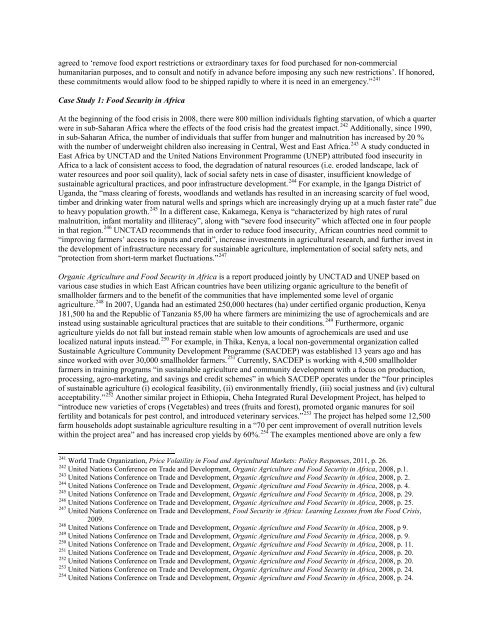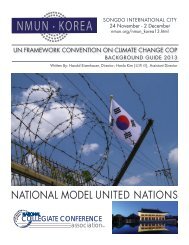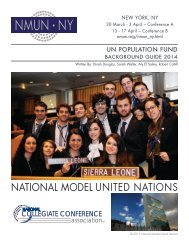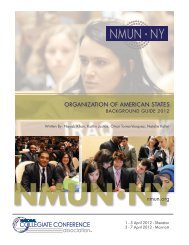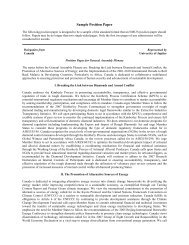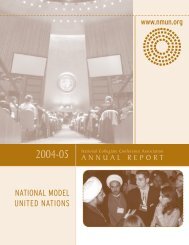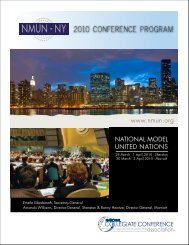UNCTAD Background Guide - National Model United Nations
UNCTAD Background Guide - National Model United Nations
UNCTAD Background Guide - National Model United Nations
Create successful ePaper yourself
Turn your PDF publications into a flip-book with our unique Google optimized e-Paper software.
agreed to ‘remove food export restrictions or extraordinary taxes for food purchased for non-commercial<br />
humanitarian purposes, and to consult and notify in advance before imposing any such new restrictions’. If honored,<br />
these commitments would allow food to be shipped rapidly to where it is need in an emergency.” 241<br />
Case Study 1: Food Security in Africa<br />
At the beginning of the food crisis in 2008, there were 800 million individuals fighting starvation, of which a quarter<br />
were in sub-Saharan Africa where the effects of the food crisis had the greatest impact. 242 Additionally, since 1990,<br />
in sub-Saharan Africa, the number of individuals that suffer from hunger and malnutrition has increased by 20 %<br />
with the number of underweight children also increasing in Central, West and East Africa. 243 A study conducted in<br />
East Africa by <strong>UNCTAD</strong> and the <strong>United</strong> <strong>Nations</strong> Environment Programme (UNEP) attributed food insecurity in<br />
Africa to a lack of consistent access to food, the degradation of natural resources (i.e. eroded landscape, lack of<br />
water resources and poor soil quality), lack of social safety nets in case of disaster, insufficient knowledge of<br />
sustainable agricultural practices, and poor infrastructure development. 244 For example, in the Iganga District of<br />
Uganda, the “mass clearing of forests, woodlands and wetlands has resulted in an increasing scarcity of fuel wood,<br />
timber and drinking water from natural wells and springs which are increasingly drying up at a much faster rate” due<br />
to heavy population growth. 245 In a different case, Kakamega, Kenya is “characterized by high rates of rural<br />
malnutrition, infant mortality and illiteracy”, along with “severe food insecurity” which affected one in four people<br />
in that region. 246 <strong>UNCTAD</strong> recommends that in order to reduce food insecurity, African countries need commit to<br />
“improving farmers’ access to inputs and credit”, increase investments in agricultural research, and further invest in<br />
the development of infrastructure necessary for sustainable agriculture, implementation of social safety nets, and<br />
“protection from short-term market fluctuations.” 247<br />
Organic Agriculture and Food Security in Africa is a report produced jointly by <strong>UNCTAD</strong> and UNEP based on<br />
various case studies in which East African countries have been utilizing organic agriculture to the benefit of<br />
smallholder farmers and to the benefit of the communities that have implemented some level of organic<br />
agriculture. 248 In 2007, Uganda had an estimated 250,000 hectares (ha) under certified organic production, Kenya<br />
181,500 ha and the Republic of Tanzania 85,00 ha where farmers are minimizing the use of agrochemicals and are<br />
instead using sustainable agricultural practices that are suitable to their conditions. 249 Furthermore, organic<br />
agriculture yields do not fall but instead remain stable when low amounts of agrochemicals are used and use<br />
localized natural inputs instead. 250 For example, in Thika, Kenya, a local non-governmental organization called<br />
Sustainable Agriculture Community Development Programme (SACDEP) was established 13 years ago and has<br />
since worked with over 30,000 smallholder farmers. 251 Currently, SACDEP is working with 4,500 smallholder<br />
farmers in training programs “in sustainable agriculture and community development with a focus on production,<br />
processing, agro-marketing, and savings and credit schemes” in which SACDEP operates under the “four principles<br />
of sustainable agriculture (i) ecological feasibility, (ii) environmentally friendly, (iii) social justness and (iv) cultural<br />
acceptability.” 252 Another similar project in Ethiopia, Cheha Integrated Rural Development Project, has helped to<br />
“introduce new varieties of crops (Vegetables) and trees (fruits and forest), promoted organic manures for soil<br />
fertility and botanicals for pest control, and introduced veterinary services.” 253 The project has helped some 12,500<br />
farm households adopt sustainable agriculture resulting in a “70 per cent improvement of overall nutrition levels<br />
within the project area” and has increased crop yields by 60%. 254 The examples mentioned above are only a few<br />
241 World Trade Organization, Price Volatility in Food and Agricultural Markets: Policy Responses, 2011, p. 26.<br />
242 <strong>United</strong> <strong>Nations</strong> Conference on Trade and Development, Organic Agriculture and Food Security in Africa, 2008, p.1.<br />
243 <strong>United</strong> <strong>Nations</strong> Conference on Trade and Development, Organic Agriculture and Food Security in Africa, 2008, p. 2.<br />
244 <strong>United</strong> <strong>Nations</strong> Conference on Trade and Development, Organic Agriculture and Food Security in Africa, 2008, p. 4.<br />
245 <strong>United</strong> <strong>Nations</strong> Conference on Trade and Development, Organic Agriculture and Food Security in Africa, 2008, p. 29.<br />
246 <strong>United</strong> <strong>Nations</strong> Conference on Trade and Development, Organic Agriculture and Food Security in Africa, 2008, p. 25.<br />
247 <strong>United</strong> <strong>Nations</strong> Conference on Trade and Development, Food Security in Africa: Learning Lessons from the Food Crisis,<br />
2009.<br />
248 <strong>United</strong> <strong>Nations</strong> Conference on Trade and Development, Organic Agriculture and Food Security in Africa, 2008, p 9.<br />
249 <strong>United</strong> <strong>Nations</strong> Conference on Trade and Development, Organic Agriculture and Food Security in Africa, 2008, p. 9.<br />
250 <strong>United</strong> <strong>Nations</strong> Conference on Trade and Development, Organic Agriculture and Food Security in Africa, 2008, p. 11.<br />
251 <strong>United</strong> <strong>Nations</strong> Conference on Trade and Development, Organic Agriculture and Food Security in Africa, 2008, p. 20.<br />
252 <strong>United</strong> <strong>Nations</strong> Conference on Trade and Development, Organic Agriculture and Food Security in Africa, 2008, p. 20.<br />
253 <strong>United</strong> <strong>Nations</strong> Conference on Trade and Development, Organic Agriculture and Food Security in Africa, 2008, p. 24.<br />
254 <strong>United</strong> <strong>Nations</strong> Conference on Trade and Development, Organic Agriculture and Food Security in Africa, 2008, p. 24.


